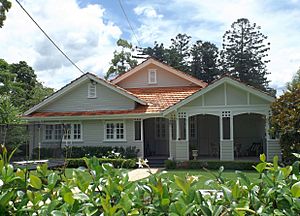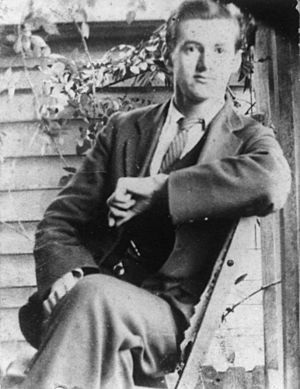Swain House facts for kids
Quick facts for kids Swain House |
|
|---|---|

Front lawn and entrance, 2014
|
|
| Location | 139 Laurel Avenue, Chelmer, City of Brisbane, Queensland, Australia |
| Design period | 1919 - 1930s (interwar period) |
| Built | 1920s - |
| Built for | Edward Swain |
| Architectural style(s) | Californian bungalow |
| Official name: Swain House | |
| Type | state heritage (built, landscape) |
| Designated | 12 December 2003 |
| Reference no. | 602427 |
| Significant period | 1920s (fabric, historical) |
| Significant components | trees/plantings, tennis court, garden/grounds, residential accommodation - main house |
| Lua error in Module:Location_map at line 420: attempt to index field 'wikibase' (a nil value). | |
Swain House is a special old house in Chelmer, Queensland, Australia. It was built a long time ago, starting in the 1920s. This house is important because of its history and the amazing gardens around it. It's even listed on the Queensland Heritage Register, which means it's protected because of its historical value.
Contents
History of Swain House
Edward Swain bought the land for this house in 1920. He was the Director of Forests in Queensland at the time. He borrowed money to build a home in the popular Californian bungalow style. By 1925, he was living there. He planted many native and foreign trees around the house. This showed his lifelong passion for forestry.
Edward Harold Fulcher Swain was born in Sydney in 1883. He became a Cadet Forester in New South Wales in 1899. He studied forestry in Montana, USA, in 1915. When he returned, he became a District Forest Inspector in Queensland. From 1918 to 1924, he was the Director of Forests in Queensland. During this time, he protected large areas of hoop pine forests. These forests were in the Brisbane and Mary River valleys. He also planted areas with trees from other countries.
In 1924, his job as Director was ended. He then became the first Chairman of the Queensland Forestry Board until 1932. This Board was in charge of managing State Forests and National Parks.
Edward Swain's Work in Forestry
Swain helped create modern forestry ideas in Queensland. His new ideas and strong personality often caused disagreements. He was a controversial figure in an industry that followed old traditions.
Some of his achievements included:
- Starting forest surveys to check tree health.
- Pushing for permanent protection of good forests.
- Improving timber pricing policies. This led to better use of wood resources.
- Expanding staff training and department activities.
He wrote several books about forestry. He also helped start the Australian Forestry School at the Australian National University. He encouraged the community to care about trees. In 1924, he helped create the Sherwood Arboretum. This park on the Brisbane River is dedicated to growing native trees.
In 1932, Swain spoke out against giving away forested land. This was a policy of the government at the time. Even though a different political party won the election, Swain lost his job after some arguments and investigations. He then worked as a research consultant in South Australia. Later, he became Commissioner for Forests in New South Wales until he retired in 1948. From 1951 to 1955, he was a United Nations Forestry Consultant in Ethiopia. Swain passed away in Brisbane in July 1970.
His daughter, Nancy, and her husband lived in the family home from 1946. She shared her father's interest in native plants. She planted many rainforest trees in the garden.
House Construction and Materials
The house itself shows Swain's interest in Australian timbers. It was built using rosewood. He wanted to prove that this wood, which was not highly thought of for building, was actually very suitable. The house also shows off other Queensland timbers. The woodwork inside includes panels made of pine and kauri.
Most of the trees planted by Swain and his family are still there. They are now large trees that make the area look beautiful. The Alan Fletcher Research Station, which is nearby, uses the hoop pine plantation for forestry research. The house also hosted social events, like a private school dance in 2007.
Description of Swain House
Swain House is a single-story timber house. It has three gables (pointed roof sections) at the front. The main roof is hipped, meaning it slopes on all sides, and is covered with terracotta tiles.
The inside of the house is mostly original. It has a sunroom at the front. The dining and living areas are connected. There is a large sandstone fireplace in the living room. The dining room has timber walls. A special cupboard with lead-light glass used to connect the dining room and kitchen. Now, it connects the kitchen and the old breakfast room. On the right side of the house are the bedrooms. At the back, there is a bathroom, a sitting room, and a maid's room. Part of the back verandah (porch) has been closed off to make another bedroom. A new open deck has been added to the back and left side of the house.
The Gardens and Trees
The house is surrounded by a large garden from the 1920s. It even has a grass tennis court. The garden contains most of the native and foreign trees planted by Swain. There are also many fruit and rainforest trees. Near the Brisbane River bank, there is a large group of hoop and kauri pine trees. There are also several mature cedar trees. A line of mature kauri trees grows along the southern edge of the property. Other trees like tallow wood, crows ash, satinay, and yellow pine are found behind the tennis court. On a slope behind the house, you can find fruit trees like loquat, mulberry, and mandarin, along with two eucalyptus trees.
Why Swain House is Heritage Listed
Swain House was added to the Queensland Heritage Register on December 12, 2003. This means it is considered very important to Queensland's history and culture. It met several important rules to be listed.
- It shows how Queensland's history has changed.
Swain House was built in the early 1920s on a large piece of land next to the Brisbane River. This land has not been divided into smaller blocks since the house was built. As a family home with such a big garden in this area, it shows an early stage of how Brisbane developed.
- It shows the main features of its type.
The house is a great example of homes from its time. It still looks mostly the same inside and out. It's rare to find a house that still has its original large garden with old native trees by the Brisbane River. Features like the maid's room and grass tennis court show a way of life that is now uncommon.
- It has special beauty.
The house and its setting, especially the old trees planted by E.H.F. Swain, are very beautiful. They make the street look much nicer.
- It is connected to important people or groups in Queensland's history.
E.H.F. Swain was a very important person in the development of forestry in Australia. His house and the trees he planted are strongly connected to his life and work. They show his interest in timber and forestry research. The hoop pine plantation is still valuable for research today.



